Dur-Sharrukin › Early Dynastic Period › Food & Agriculture in Ancient Greece » Origins and History
Articles and Definitions › Contents
- Dur-Sharrukin › Ancient History
- Early Dynastic Period › Ancient History
- Food & Agriculture in Ancient Greece › Antique Origins
Ancient civilizations › Historical places, and their characters
Dur-Sharrukin › Ancient History
Definition and Origins
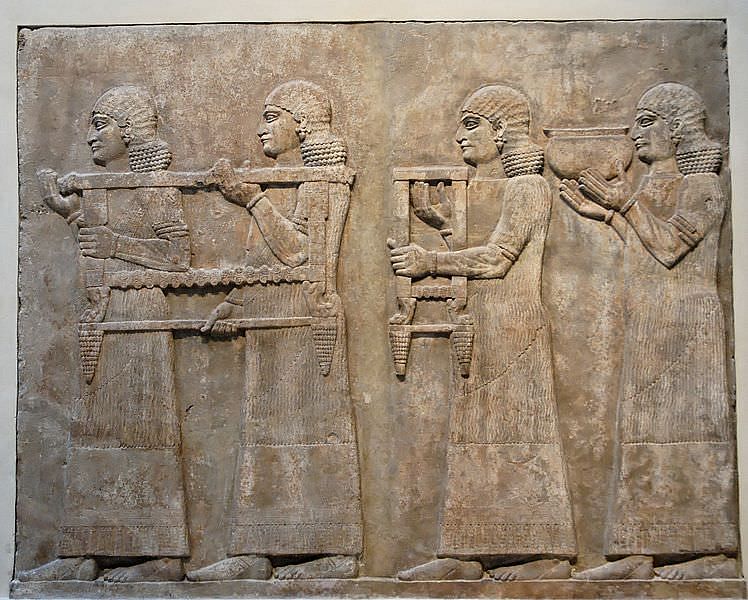
Dur-Sharrukin (modern day Khorsabad, Iraq) was a city built by Sargon II of Assyria (reigned 722-705 BCE) as his new capital. The name means “Fortress of Sargon ” and the building project became the king's near obsession as soon as it was conceived. The city covered 1.11 square miles (1.78 kilometers) with a length of 5,770 feet (1,758.6 meters) and a width of 5,364 feet (1,635 meters) and was surrounded by a wall which was 45 feet (14 meters) thick and 39 feet (12 meters) high. The city was built, from Sargon's design, to form a near perfect square from which rose a “palace without rival” (as Sargon described it) and a four-story ziggurat. The historian Stephen Bertman comments on the construction and design writing :
Sargon's capital city was over a mile square and its design became his preoccupation. The city's dimensions, for example, were based on the numerological value of Sargon's name. Tablets describing the story of the palace's construction were deposited in its cornerstone with the identical text repeated on individual tablets of copper, lead, silver, gold, limestone, magnesite, and lapis lazuli, while paintings illustrated how cedar wood was imported from Lebanon to provide needed timber. Colossal stone bulls with wings and human heads guarded its entranceways. And the walls of the palace were decorated with so much sculpture that the panels, if laid end to end, would stretch for a mile (19).
Construction began in 717 BCE and would continue for the next ten years. Sargon II was away on campaign during much of this time but kept in touch with his son, the crown prince Sennacherib, regarding the city's progress. He moved in to his new palace in 706 BCE but died on campaign a year later. After his death, the city was abandoned.
SARGON II HAD WANTED A CITY MORE BEAUTIFUL THAN KALHU OR ASHUR, A CITY NO ONE BEFORE HIM HAD LIVED IN, AND NOW HE HAD IT.
THE NEED FOR A NEW CAPITAL
The city of Ashur had been the traditional capital of the Assyrian Empire until the reign of King Ashurnasirpal II (884-859 BCE) who moved the capital to his newly-built city of Kalhu (also known as Nimrud ). Ashurnasirpal II decided on this move in order to separate his reign from those of his predecessors but also because the people of Ashur had become more independent owing to the great wealth and prestige of the city. Ashurnasirpal II felt he could no longer count on the populace to unwaveringly support him and wanted a new city, with a new palace, to assert his authority. Kalhu proved to be just the city he was looking for. It had first been built under the reign of Shalmaneser I (reigned 1274-1245 BCE) but had become dilapidated in the years since his reign. Ashurnasirpal II renovated the city, rebuilt the temple, had a new palace constructed, and inaugurated the city as his capital in 879 BCE. Kalhu served the kings of Assyria over the next century but, in 746 BCE, the usurper Tiglath Pileser III (reigned 745-727 BCE) overthrew the ruling monarch and took the throne. Regarding this, the historian Karen Radner writes:
That Kalhu's elite could no longer be seen as unquestioningly loyal to whoever happened to be king became very clear in 746 BCE. In that year, a rebellion against king Ašš ur -nerari V (754-745 BCE) started in Kalhu, in the very centre of the Assyrian state. The revolt was successful and eventually resulted in the ascension of Tiglath-Pileser III to the throne. Having profited from Kalhu's new-found independence from the royal court, he and his chosen heir Shalmaneser V (726-722 BCE) had little reason to fear it. Sargon II, however, faced fierce resistance to his rule after he ousted his brother Shalmaneser in 722 BCE and usurped royal power. Rebellions arose in the western provinces but also, and much more worryingly, in the Assyrian heartland. After he managed to crush the opposition in 720 BCE, he exiled those of his enemies in central Assyria who had survived. Moreover, he immediately took steps to relocate the court and central administration (1).
Dur-Sharrukin was envisaged as a completely new beginning for Sargon II. He purchased the land from an agricultural community called Magganubba and claimed to have paid the going market price without invoking any kind of royal privilege.Sargon II writes in one inscription:
Magganubba, which lies at the foot of Mount Muṣri and towers above a spring and the surroundings of Nineveh - none of the 350 earlier regents of Assyria realized its favorable location, understood the benefits of its settlement or commanded to dig a canal there. I planned and plotted day and night how to settle this city and to build a sanctuary as the seat of the great gods and palaces as the residence of my rule, and therefore commanded their construction (Khorsabad cylinder inscription, ll. 44-49)
Once the land had been purchased and construction had begun, Sargon II needed to leave on military campaigns to secure his empire. He continued to oversee his project from afar, however, as is clear from his letters to his son and to those directly involved in building the city.
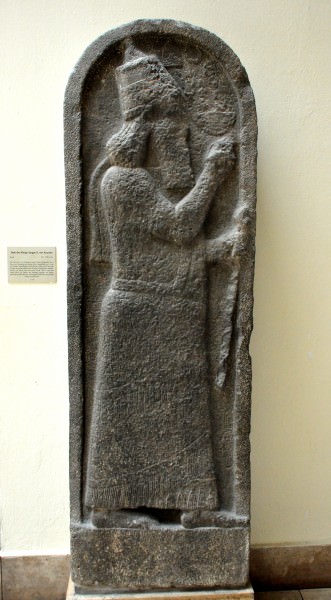
Sargon II's Stele
CONSTRUCTION OF THE CITY
Sargon II was no longer interested in ruling from Kalhu and wanted the city built quickly. He was also interested in quality, however, and wanted to make sure it was built well. He canceled the debts of workers in order to procure a steady stream of labor and had his overseers give incentives to skilled workers. He also, no doubt, used the forced labor of prisoners of war and those civilian populations which had been relocated following conquest (such as the people of Israel and Samaria, whom he conquered early in his reign, c. 720 BCE). His level of personal involvement in the project is made clear through the letters he sent home. The historian Marc Van De Mieroop writes:
A total of 113 letters can be associated with the building of Dur-Sharrukin, a tenth of all preserved letters from his reign. They involve twenty-six provincial governors, which shows how resources from the entire empire were used. Six letters seem to have been written by the king himself, demanding materials or labor. Three of them are translated here:1 Letter found in NinevehThe king's word to the governor of Kalhu: 700 bales of straw and 700 bundles of reed, each bundle more than a donkey can carry, must arrive in Dur-Sharrukin by the first of the month Kislev. Should one day pass by, you will die.2 Letters found in KalhuThe 1100 limestones that Bel-lishir-talaktu is loading, let them be brought to me in Dur-Sharrukin quickly!Addressed to the second vizier.700 limestones that Bel-lishir-talaktu is loading, quickly bring them to me in Dur-Sharrukin! Addressed to the eunuchs (235).
The city rose steadily through the efforts of a massive labor force even though, at times, there were accidents and delays. One such accident was the loss of two winged bull colossi in the river Tigris. The official overseeing the movement of the statues wrote to the king saying,
To the king, my lord: your servant Assur -bani. Good health to the king, my Lord! Assur-sumi-ke'in called me to help and loaded the bull colossi on the boats, but the boats could not carry the load and sank. Now, although it cost me a great trouble, I have now hauled them up again.
Between 713-710 BCE Sargon II remained, more or less, in Kalhu and regularly oversaw the construction of his city. In 710 BCE he felt he had to finally deal with a problem which had bested him early in his reign. A tribal chief named Merodach-Baladan had taken Babylon and, with Elamite allies, had defeated Sargon II's forces in c. 719 BCE and had then claimed the throne of Babylon and the southern reaches of Mesopotamia. Sargon II again entrusted the building of Dur-Sharrukin to Sennacherib and marched his forces against Elam.
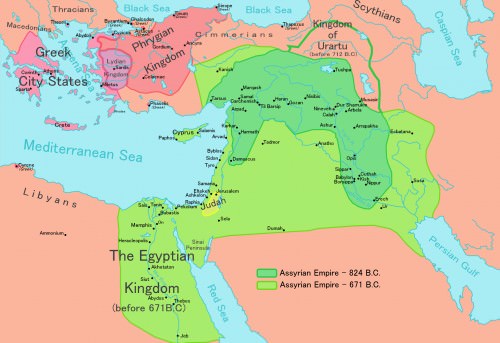
Neo-Assyrian Empire
BABYLON, DEATH, & THE END OF DUR-SHARRUKIN
Sargon II had been defeated previously by the Elamites and Babylonians because he faced them in a frontal assault on the field. This time he swung his armies to the east and first defeated Elam in order to deprive Babylon of its allies. Merodach-Baladan fled the city and Sargon II entered Babylon, had himself crowned king, and accepted the territories of the south in his role as liberator. He then remained at Babylon for the next three years until word reached him that his city was complete and he could move into his palace.
The city was not actually complete. The walls were done and most of the buildings and, most importantly, the palace, but excavations at the site and ancient letters indicate there was still some significant work to be done. Even so, the city was very impressive. The historian Gwendolyn Leick writes:
There were seven gates, each dedicated to an Assyrian god. Within a separate enclosure stood the palace and the administrative complex known as the “Palace without Rival”. According to the French excavators, it contained more than 210 rooms, grouped around three courtyards. The portals were guarded by colossal human-headed, winged bulls made of stone, and the walls of the palace were lined with relief-covered limestone slabs that showed the triumph of the Assyrian army and the deeds of Sargon. There were several sanctuaries at Dur-Sharrukin; the most notable was dedicated to the god Nabu and decorated with glazed tiles (51-52).
Further, there was the great ziggurat of Dur-Sharrukin: a four-story structure with a spiral staircase winding up around it. Each of the levels was painted a different color: white, black, red, and blue. The doors of the palace were bronze, while carved ivory decorated the walls and ceilings. The reliefs that lined the walls depicted Sargon II as a mighty king who destroyed his enemies and built towering monuments. The historian Susan Wise Bauer comments on this, writing how the reliefs “show his greatness. His huge figure pushes even the forms of the gods into the background” (381). He had wanted a city more beautiful than Kalhu or Ashur, a city no one before him had lived in, and now he had it.
He did not enjoy it for very long. Sargon II moved into his grand palace in 706 BCE and, in 705 BCE, was killed in battle. The Tabal people of Anatolia had risen against the Assyrian Empire and, instead of sending a general to take care of the problem, Sargon II led his army himself. He was killed on the field and the fighting was so fierce that his men could not retrieve his body.This was considered a bad omen by the people of Assyria who concluded that Sargon II must have committed some terrible sin for the gods to have deserted him so completely when he needed them most. Since Dur-Sharrukin was so closely associated with the king, it was thought to have been tainted by whatever transgression against the gods he had committed and so was abandoned. Sennacherib moved the capital to Nineveh and initiated his own building projects there. Anything which could be moved was taken from Dur-Sharrukin and brought to Nineveh. The city was deserted. While some modern-day scholars claim that Dur-Sharrukin continued on as a provincial capital, others contend that it became effectively a ghost town after the move to Nineveh. The discrepancies in these views come from different interpretations of the modern-day site and the ancient inscriptions.
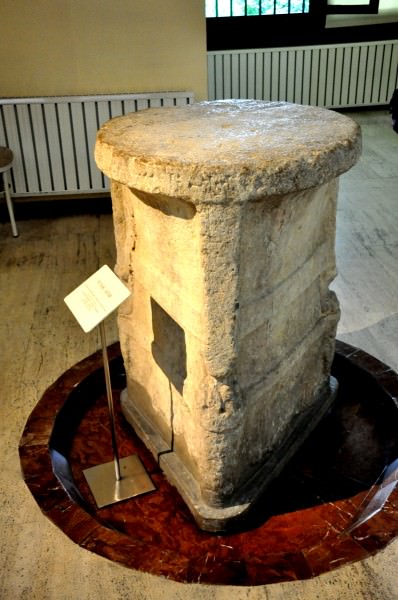
An Altar from Dur-Sharrukin
COLLAPSE & LATER DISCOVERY
Dur-Sharrukin eventually collapsed in the fires which took the region after the fall of the Assyrian Empire in 612 BCE. The combined forces of the Persians, Medes, Babylonians, and others swept through the cities of the Assyrians following the death of Sargon II's great-grandson, King Ashurbanipal, in 627 BCE and destroyed them. In time, the ruins were buried by the sands and the city was forgotten. The settlement known as Khorsabad came to be established on the spot, and then, in 1873 CE the archaeologist Paul Emile Botta began excavations there. These were later carried on by another archaeologist named Victor Place. These men were accompanied, as was standard practice, by artists who would sketch the ruins and the artifacts which were to be moved in situ. Artists like Eugene Flandin and Felix Thomas made careful drawings of every artifact discovered at Dur-Sharrukin, and it was very fortunate that they did.
One boatload of treasures that was being shipped down the Tigris River in 1853 CE was attacked by Bedouins and sank, while another boatload in 1855 CE sank under the weight of the artifacts which had been loaded on to it. The second sinking resulted in the loss of two bull colossi, possibly the same two colossi which had sunk the boats in the 8th century BCE. Unlike the workmen under Sargon II, however, no attempts were made in the 19th century CE to retrieve the treasures from the bottom of the Tigris River and they remain there to the present day. In part due to military conflicts in the region, any plans to raise the sunken treasures in the latter 20th and early 21st centuries CE have never been implemented.
Those artifacts which did wind up leaving the country may be viewed today in the British Museum, the Louvre, The Oriental Institute of Chicago in the USA and, in country, at the Archaeological Museum in Iraq. Excavations at the site continued into the mid-20th century CE, with the Oriental Institute of Chicago overseeing the work there from 1928-1935 CE. The Iraqi Department of Antiquities took over the site in the 1950's CE, and further excavations were conducted under their authority with finds going to the museum in Baghdad. No further work has been carried out at Dur-Sharrukin and, as with the artifacts at the bottom of the Tigris River, this is partly due to armed conflict in the region.
Early Dynastic Period › Ancient History
Definition and Origins
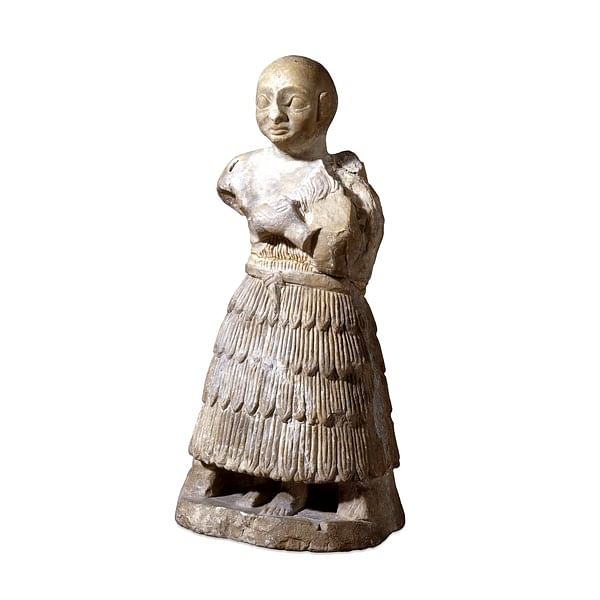
Southern Mesopotamia was divided between competing city -states during the period 2900-2300 BCE. This so-called Early Dynastic period has three subdivisions based on archaeological finds made by the Oriental Institute of Chicago in the area of the Diyala, east of modern Baghdad. Early Dynastic I (around 2900-2800 BCE) saw the emergence of large independent cities such as Uruk. The cities were controlled by a king and his family, who owned vast estates.
Early Dynastic II (around 2800-2600 BCE) saw an increase in building and an improvement in the quality of artistic products like chlorite bowls, which also show connections with regions beyond Mesopotamia. The Early Dynastic II may be the period of rulers, like Gilgamesh, whose names survive in later legends.
The earliest writing is largely administrative, but by the beginning of Early Dynastic III (2600-2300 BCE) inscribed clay tablets contain many literary texts, including poetic hymns. Some of the best evidence for this period comes from the Royal Graves at Ur and the Dynasty of Lagash.
Food & Agriculture in Ancient Greece › Antique Origins
Ancient Civilizations
The prosperity of the majority of Greek city -states was based on agriculture and the ability to produce the necessary surplus which allowed some citizens to pursue other trades and pastimes and to create a quantity of exported goods so that they could be exchanged for necessities the community lacked. Cereals, olives, and wine were the three most produced foodstuffs suited as they are to the Mediterranean climate. With the process of Greek colonization in such places as Asia Minor and Magna Graecia Greek agricultural practice and products spread around the Mediterranean.
A NETWORK OF SMALLHOLDINGS
The state did not control farming and crops were grown and livestock reared by private individuals on their own land. Indeed, the widespread practice of not permitting non-residents to own land meant that smallholdings were the norm. Another important factor which limited the amalgamation of land plots over time was that male children generally inherited equal shares of their parents' land. Farms at Athens ranged in size from 5 ha (the poorer citizens) to 5-10 ha (middle class) and 20 ha (the aristocracy). In Sparta farms were a little bigger on average, ranging from 18 ha for the smaller ones to 44 ha for those belonging to the richest citizens. The poorest citizens had no land at all and so, if they had no other skills of benefit to the community such as crafts, would have worked on the land of others for pay or leased land to work it themselves.
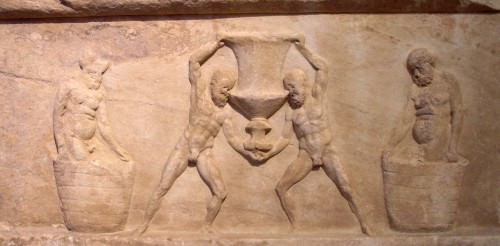
Satyrs Making Wine
It is not clear if farmers always lived on their farms or resided in the city and travelled each day. It seems reasonable to suppose there was a mixture of both approaches which was probably dependent on the location of the land inherited by an individual (ie the proximity to the city and separation from other plots they owned) and their personal status such as being able to afford slaves (or helots in the case of Sparta) to work the land.
ONLY ONE-FIFTH OF GREECE HAS ARABLE LAND SO PRESSURE TO MAKE BEST USE OF IT WAS HIGH.
CROPS
The crops produced by the ancient Greeks were, of course, selected for their suitability to the Mediterranean climate. This has a combination of dry hot summers with mild winters providing plentiful rainfall. The irregularity of annual rainfall did mean that crop failure was a regular problem, though. Wheat crops may have failed once every four years and barley crops once every ten years because of insufficient water supply. Terrain, localised weather conditions, and different soils were also factors in making some areas more fertile than others. Indeed, as a whole, only one-fifth of Greece has arable land so pressure to make best use of it was high.
The most widely cultivated crop was wheat - especially emmer ( triticum dicoccum ) and durum ( triticum durum ) – and hulled barley ( hordeum vulgare ). Millet was grown in areas with greater rainfall. Gruel from barley and barley-cakes were more common than bread made from wheat. Pulses were grown such as broad beans, chickpeas, and lentils. Vines to make wine and olives to produce oil completed the four main types of crops in the Greek world. Fruit (eg figs, apples, pears, pomegranates, quinces, and medlars), vegetables (eg cucumbers, onions, garlic, and salads) and nuts (eg almonds and walnuts) were grown by many private households.

Silver Stater, Metapontum
CROP MANAGEMENT
Ploughing and sowing was carried out in October-November-December. It is interesting to note that there were no distracting religious festivals or records of Assembly meetings in Athens during this crucial and busy period. Vines were pruned back in the early spring, and grain harvested in May-June. Winnowing, threshing, and storage were done in June-July while grapes were gathered and made into wine and figs collected in September. In the autumn olives were harvested and pressed into oil.During the winter some hardier crops were sown and fields maintained.
There is evidence of crop rotation, and fields were left fallow to allow soil nutrients to regenerate and moisture to build up. In more pressing times some fields would have been used continuously throughout the year or planted with multiple crops at the same time. Such crops as beans and lentils were also grown and reploughed back into the field to re-fertilise it or weeds could be left to grow as food for grazing animals. Small plots used for growing fruit and vegetables would have been irrigated with small water channels and cisterns. Trenches, if labour were available, were dug around trees to hold precious rainwater for where it was most needed.
Equipment used in Greek agriculture was basic with digging, weeding, and multiple ploughing done by hand using wooden or iron-tipped ploughs, mattocks, and hoes (there were no spades). Richer farmers had oxen to help plough their fields. Sickles were used to harvest crops, which were then winnowed using a flat shovel and baskets. Grains were then threshed on a stone floor which was trampled on by livestock (and which might also have dragged sledges for the purpose too). Grapes were crushed underfoot in vats while olives were crushed in stone presses.

Fish Plate
ANIMAL HUSBANDRY
The ancient Greeks did not manage large herds of livestock for the purposes of creating a saleable surplus and specialised pastoralism, with its necessity to seasonally move animals between pastures in different climate zones (transhumance), is not recorded until the Classical period in Greece. However, many private households would have kept a small number of animals, perhaps no more than 50 in a herd would have been the norm. These included sheep, goats, pigs, chickens, and some cattle.They were useful for their meat, milk to make cheese (it was rarely drunk), eggs, wool or leather, and to fertilise crops. Animals were reared in greater numbers where the local terrain was not suitable for agriculture. These animals, besides having access to naturally occurring areas of grazing, were fed fodder of chaff and straw, stalks of vegetable plants, fallen and damaged fruit, and the residues of grapes and olives after pressing. Horses, mules, and donkeys were also reared for transport.
TRADE OF FOODSTUFFS
Most farmers would have only produced sufficient foodstuffs for their own family's needs but they would have bartered surplus produce for everyday necessities and foodstuffs they did not produce themselves such as cheese, honey, fish, and shellfish.Some of the wealthier citizens with larger plots did certainly produce cash crops which they could sell in bulk at markets.Agricultural products traded within Greece between citizens at markets and different cities included cereals, wine, olives, figs, pulses, eels, cheese, honey, and meat (especially from sheep and goats). From the 5th century BCE, Athens' port of Piraeusbecame the most important trading centre in the Mediterranean and gained a reputation as the place to find any type of goods on the market.
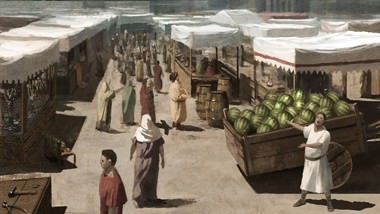
Market Scene
Greek merchant ships plied the Mediterranean and exported goods to such places as Egypt, Magna Graecia, and Asia Minor.Foodstuff exports included wine, especially from Aegean islands like Mende and Kos, olives and olive oil (transported, like wine, in amphorae ). By-products such as hides were exported too, especially from Euboea. Many Greek city-states continued to function as important trade centres throughout the Hellenistic and Roman periods, especially the free-trade ports of Athens, Delos, and Rhodes.
STATE INTERVENTION
The involvement of the state in trade and the sale of agricultural products was relatively limited; however, a notable exception was grain, imported from Egypt and the Black Sea area, to ensure that in times of drought populations did not starve. For example, so vital was it to feed Athens' large population that trade in wheat was controlled and purchased by a special 'grain buyer' ( sitones ). From c. 470 BCE the obstruction of the import of grain was prohibited, as was the re-exportation of it; for offenders the punishment was the death penalty.
Market officials ( agoranomoi ) ensured the quality of goods on sale in the markets and grain had its own supervisors, the sitophylakes, who regulated that prices and quantities were correct. Although city-states did often impose taxes on the movement of goods and levies on imports and exports at ports, there were also measures taken to protect internal trade and more heavily tax goods which were destined for, or came in from, areas outside Greece. There were also trade incentives such as on Thasos to encourage the export of their high-quality wine.
LICENSE
Article based on information obtained from these sources:with permission from the Website Ancient History Encyclopedia
Content is available under License Creative Commons: Attribution-NonCommercial-ShareAlike 3.0 Unported. CC-BY-NC-SA License